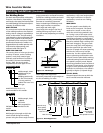
11
Troubleshooting Chart - Welder
Symptom Possible Cause(s) Corrective Action
For Information About This Product Call 1-800-746-5641
Troubleshooting Chart - Welds
Symptom Possible Cause(s) Corrective Action
1. Duty cycle exceeded
2. Poor work clamp connection
3. Defective power switch
4. Blown breaker or fuse
1. Wrong size gun tip
2. Gun liner clogged or
damaged
3. Gun tip clogged or damaged
4. Feed roller worn
5. Not enough tension
1. Slag inside gun nozzle
2. Insulation ring melted/expired
1. Poor contact
2. Using an extension cord with
excessive length
1. Wire jammed
2. Out of wire
3. Not enough tension
4. Wire liner worn
5. Wire disconnected internally
6. Contact tip clogged
1. Wire speed too slow
2. Travel speed too slow or heat
is too high
1. Wire speed setting
2. Contact tip size too large
3. Polarity set incorrectly
4. Drive roller slipping
5. Gas bottle empty
1. Allow welder to cool until ON/OFF Switch lamp goes out
2. Be sure all connections are secure, and attaching surface is
clean
3. Replace switch
4. Reduce circuit load, reset breaker or replace fuse
1. Use proper size gun tip
2. Clean or replace gun liner
3. Clean or replace gun tip
4. Replace
5. Tighten tensioning screw
1. Clean slag from gun nozzle
2. Replace nozzle
1. Be sure all connections are secure, and attaching surface is
clean
2. Never use an extension cord longer than 20 ft
1. Reload wire
2. Replace wire spool
3. Tighten tensioning screws if wire is slipping
4. Replace liner
5. Call 1-800-746-5641 for assistance
6. Replace contact tip
1. Run speed in 7 - 10 range
2. Increase the travel speed or reduce heat settings
1. Tune in correct setting
2. Replace contact tip
3. Reverse polarity
4. Increase tension
5. Replace gas bottle
No output
Wire tangles at drive roller
Gun nozzle arcs to work
surface
Work clamp and/or cable
gets hot
Wire does not feed
(Aluminum) Wire burns back
into tip or (Aluminum) Metal
bubbles or burns through
Weld pops and sputters
Bead is intermittently
too thin
Bead is intermittently
too thick
Ragged depressions at
edge of weld
Weld bead does not
penetrate base metal
Wire sputters and
sticks
1. Inconsistent travel speed
2. Output heat setting too low
1. Slow and/or inconsistent travel speed
2. Output heat setting too high
1. Travel speed too fast
2. Wire speed too fast
3. Output heat setting too high
1. Inconsistent travel speed
2. Output heat setting too low
3. No or low shielding gas
4. Wrong shielding gas (aluminum)
5. Extension cord is too long
6. (Aluminum) Possible oxide buid-up on
surface
1. Damp wire
2. Wire speed too fast
3. Wrong type of wire
4. No or low shielding gas
1. Decrease and maintain constant travel speed
2. Increase output heat setting
1. Increase and maintain travel speed
2. Reduce output heat setting
1. Decrease travel speed
2. Decrease wire speed
3. Reduce output heat setting
1. Decrease and maintain constant travel speed
2. Increase output heat setting
3. Use gas for MIG process or refill bottle
4. Use only 100% Argon gas
5. Never use an extension cord longer than 20 ft
6. Clean surface thoroughly with a stainless steel brush only
1. Use dry wire and store in dry location
2. Reduce wire speed
3. Use flux core wire when not using gas
4. Use gas for MIG process or refill bottle
www.chpower.com
Model WG2040, WG2044, WG2045, WG3000


















